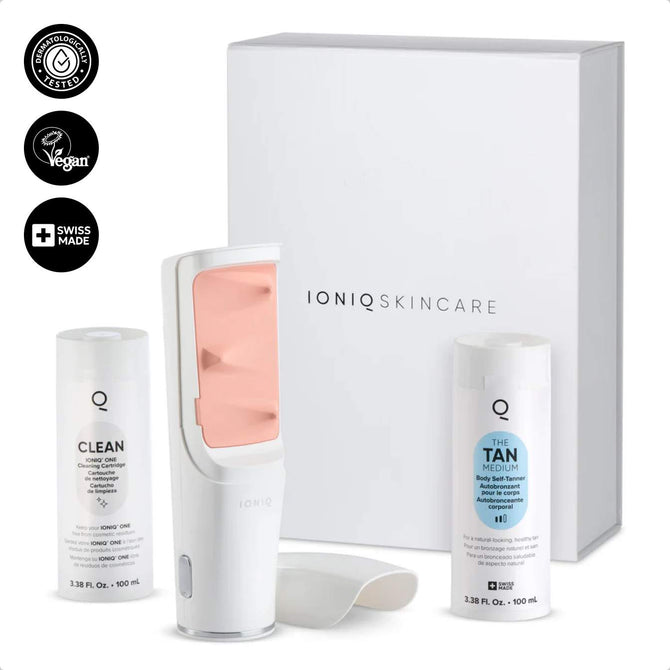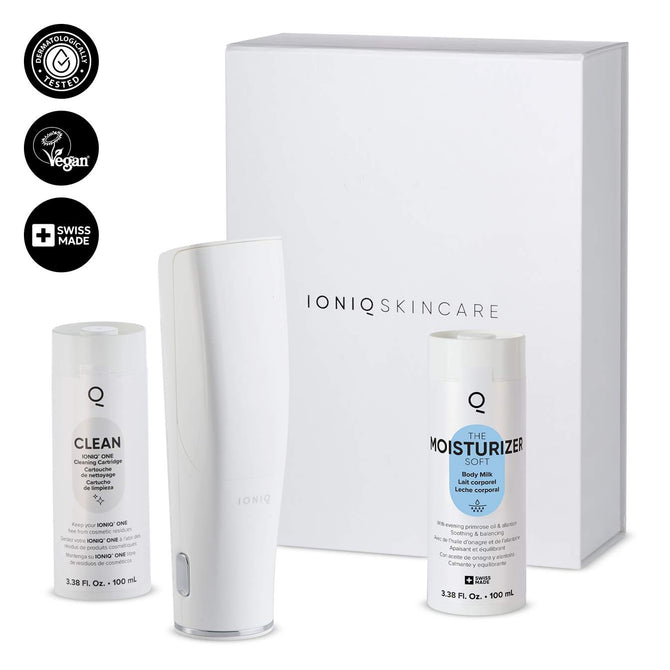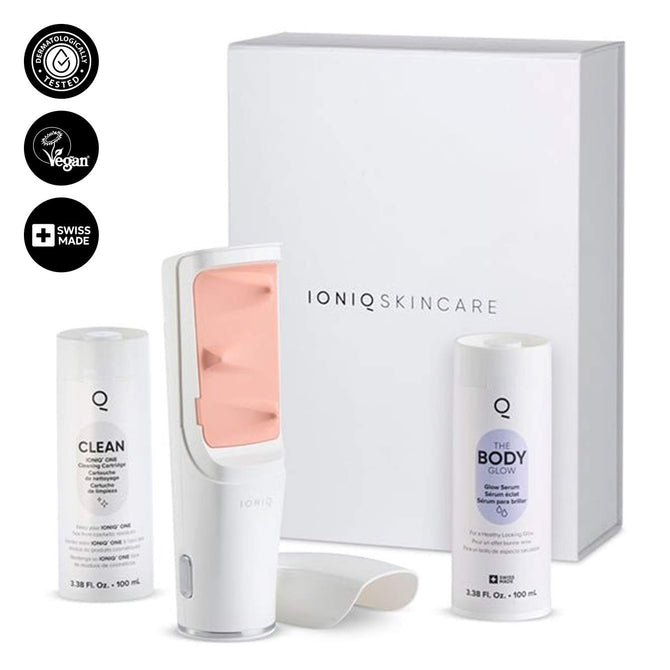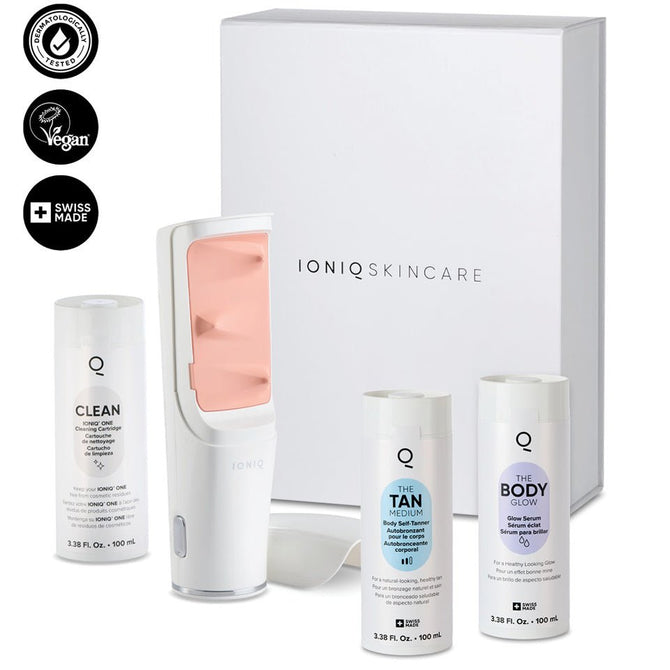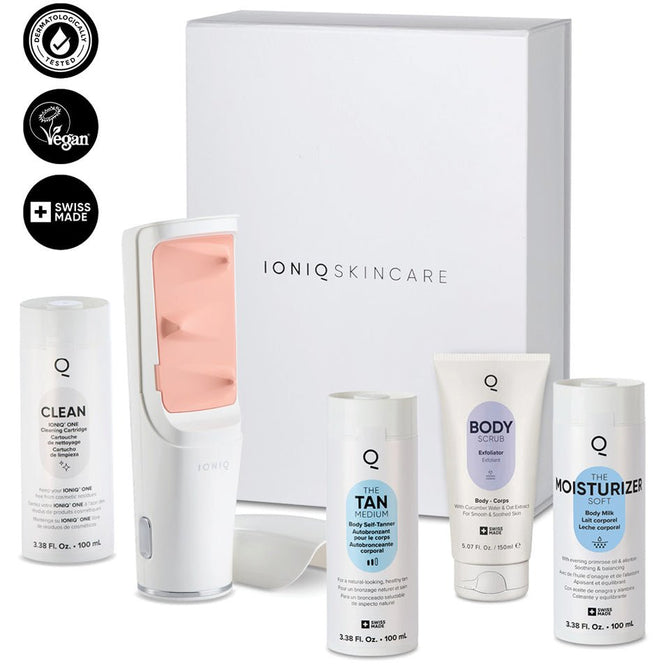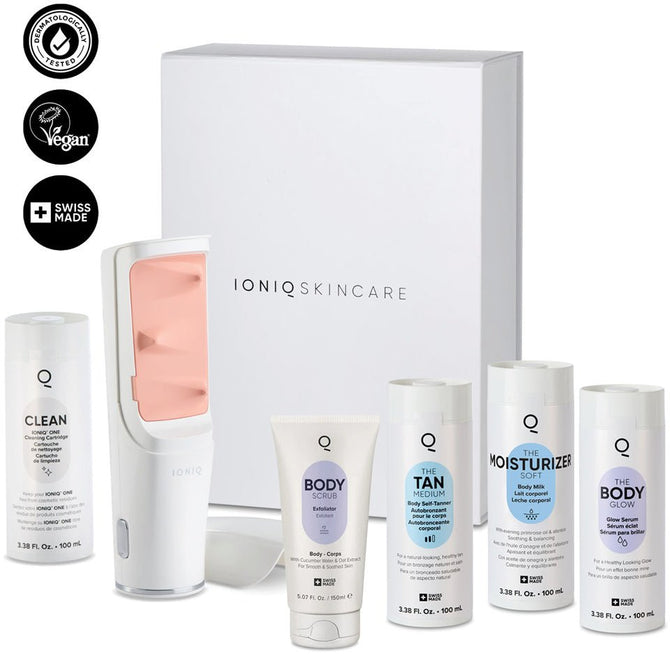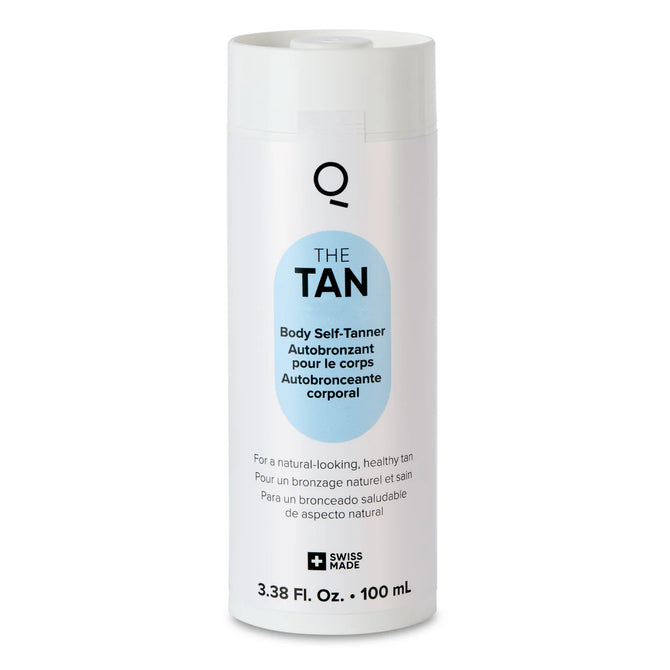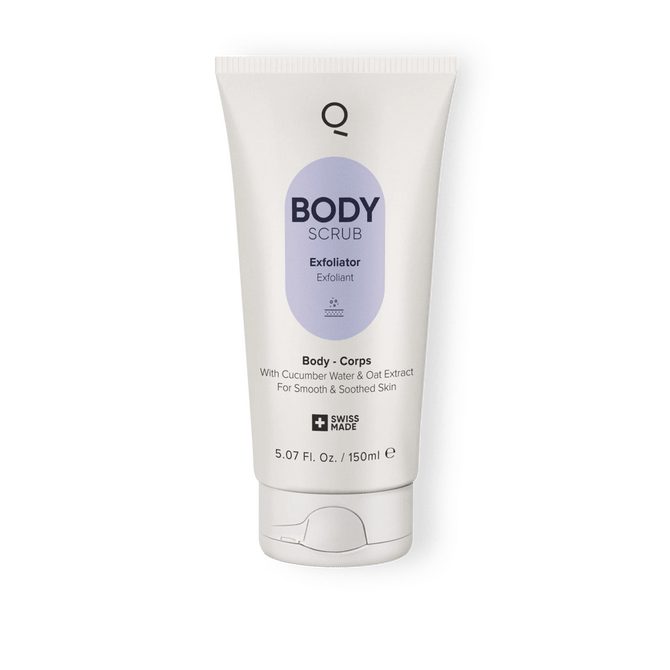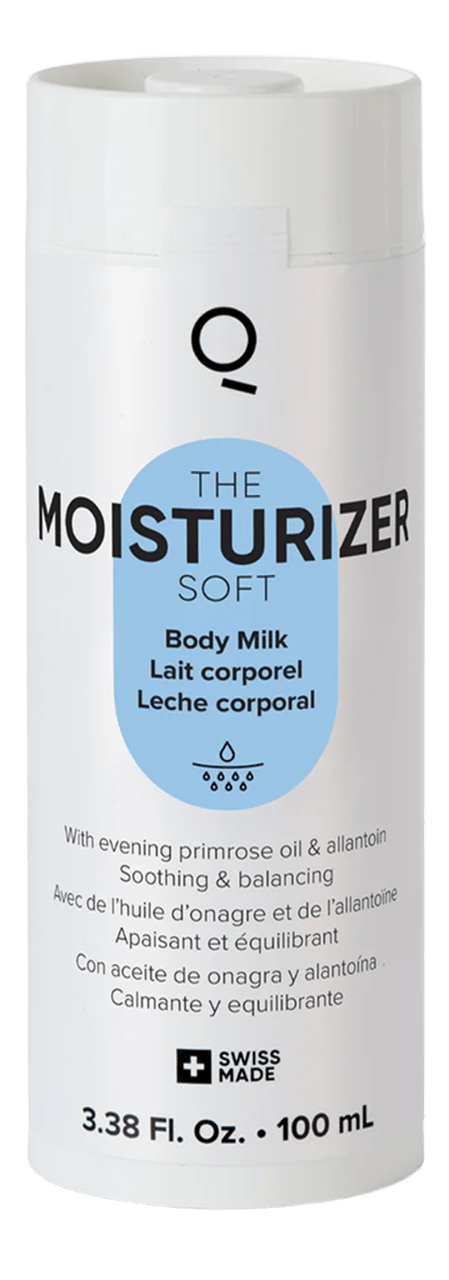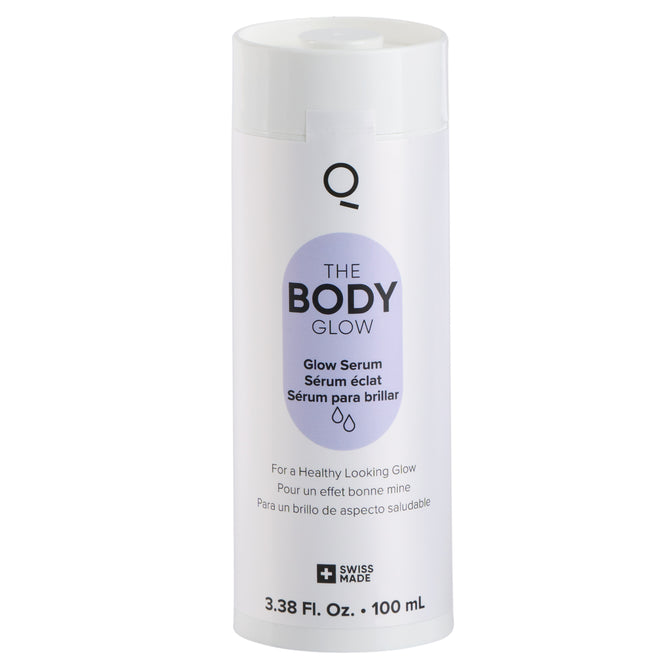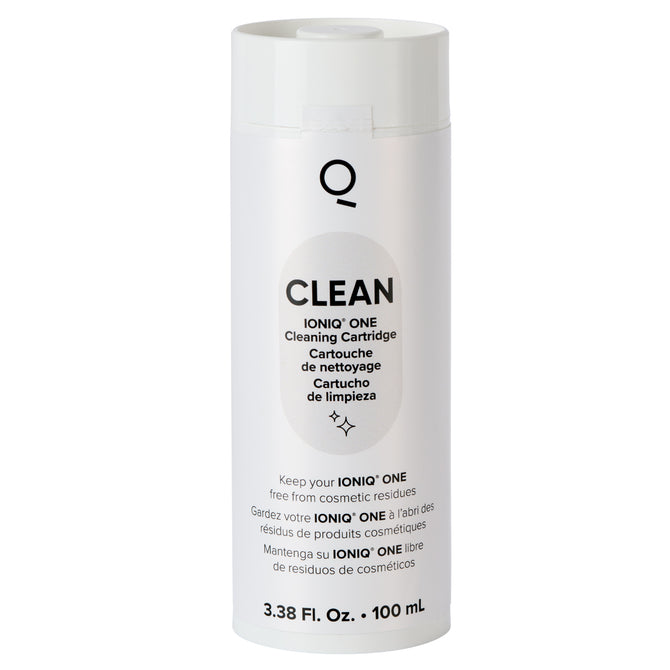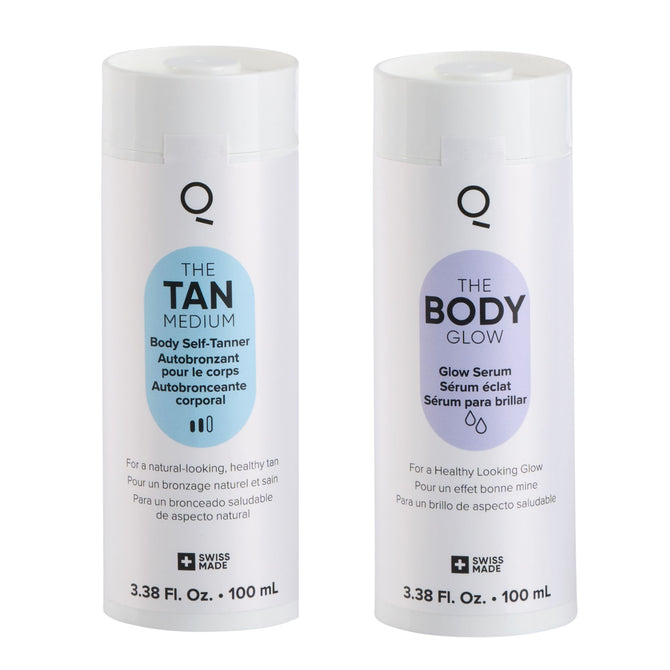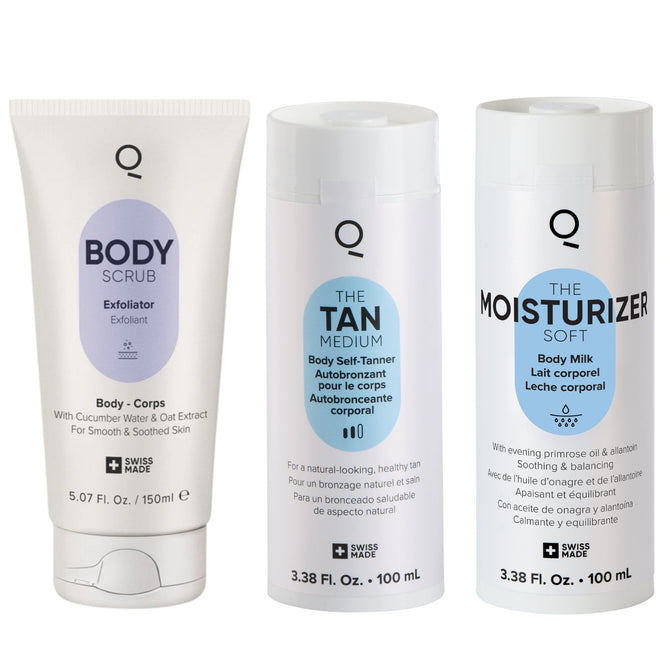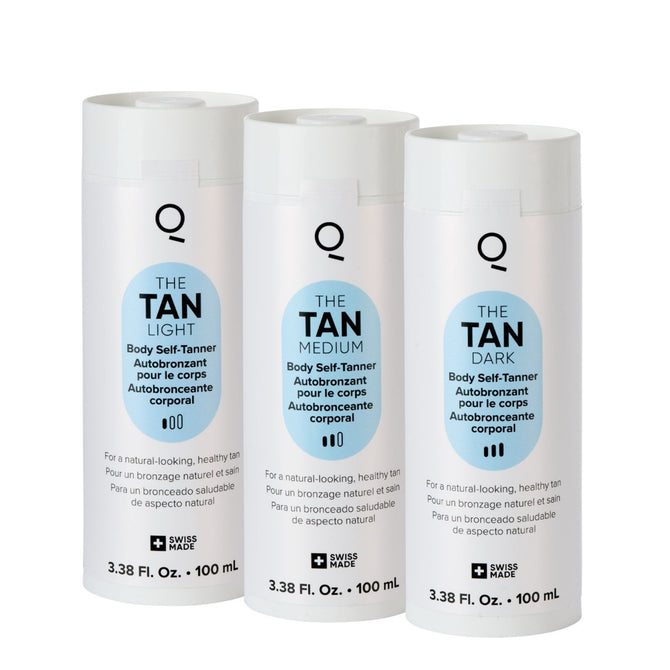
Spray tans are supposed to give you that smooth, sun-kissed look—no sunburns, no streaks, just glow. But if you’ve ever ended up with orange ankles, patchy arms, or stubborn color that clings for days, you’re not alone. Figuring out how to remove a spray tan can feel like a frustrating guessing game, especially when all you want is your skin back to normal.
Whether you’re dealing with blotchy leftovers, prepping for a fresh tan, or trying to fix one gone wrong, there’s a right way (and plenty of wrong ways) to take a spray tan off. The trick isn’t just getting rid of the color—it’s doing it without damaging your skin or making the next application worse.
In this guide, we’ll break down what actually gets spray tan off fast, how to treat tricky spots like feet and hands, and how to avoid the common mistakes that lead to patchy fades in the first place. And if you're tired of the mess, the streaks, or the endless salon visits, we'll also explore a cleaner, smarter way to tan at home—one that skips all the stress entirely.
Let’s start by understanding why your tan fades the way it does… and how to finally get it under control.
Why Spray Tans Fade Unevenly (And What You Can Do About It)
Spray tans don’t always fade the way we want them to. One day your skin looks flawless, and the next, your elbows are too dark, your feet are patchy, and your hands have started to turn a weird shade of orange. The problem isn’t just how a spray tan looks going on—it’s how unevenly it disappears.
Understanding how spray tans work on your skin
Spray tanning works by applying a chemical called DHA (dihydroxyacetone) to the surface of your skin. This colorless compound reacts with the outer layer—made up of dead skin cells—and creates a brownish tint that mimics a natural tan. But because this layer of skin is always shedding, your tan starts to fade almost immediately, even if it looks flawless at first.
The fade isn’t uniform, though. That’s because your skin doesn’t renew itself evenly. Areas that are dry, rough, or experience more friction tend to hang on to the tanning pigment longer—or lose it faster—than areas with smoother, healthier skin. This is why spray tans often start to break up in patches on knees, elbows, hands, and feet.
The way your tan develops and fades also depends heavily on how evenly it was applied in the first place. If the application isn’t precise, you’re more likely to deal with dark spots, uneven color, or quick fading in unexpected places.
What causes patchiness and buildup after a spray tan
There are several common reasons why spray tans start to fade in strange patterns:
-
Dry skin: Rough areas absorb more DHA, creating darker spots that cling longer.
-
Inconsistent exfoliation before tanning: Skipping this step can cause buildup in certain areas.
-
Friction from clothing or bedding: Constant rubbing can cause color to fade faster in high-contact zones.
-
Sweating during development time: Moisture can cause streaks or light patches.
-
Overapplication in folds and creases: Product settling into lines can cause tan buildup.
This uneven breakdown is why it’s so important to prep properly before spray tanning and to take care of your skin afterward. But even with perfect prep, many traditional tanning methods still struggle to deliver an even result—especially on areas that are tough to reach or tend to develop darker than others.
That’s where having the right at-home tanning solution makes a difference. The IONIQ ONE Sprayer + TAN, with its 360° wrap-around mist and Magnetic Skin Technology, helps you apply a streak-free tan that reaches even tricky areas like the backs of arms and ankles.
Knowing what’s really happening on your skin helps you better manage the life cycle of a spray tan. And once you understand why the color breaks down unevenly, you can remove it more effectively—and avoid the patchy mess next time.
How to Remove a Spray Tan Without Damaging Your Skin
The best methods for gentle, effective removal
If you’re ready to take off a spray tan, patience and prep matter more than force. You want to encourage your skin to shed the tinted layer naturally—not damage it by scrubbing it raw. Gentle methods often work faster in the long run because they don’t leave your skin irritated, inflamed, or more prone to absorbing pigment unevenly next time.
Some of the most effective ways to get spray tan off skin gently include:
-
Warm baths: Soaking in a warm tub softens skin and loosens the top layer.
-
Oil-based products: Coconut oil, baby oil, or a natural oil blend can help break down the DHA residue.
-
Moisturizing exfoliants: Sugar scrubs or soft mitts remove color without scraping your skin.
-
Steam: Spending time in a steamy bathroom can help loosen stubborn patches before exfoliating.
Rather than jumping to “how to remove a spray tan quickly,” think about how to help your skin let go of it naturally. This minimizes irritation, especially if you plan to tan again soon.
Why scrubbing harder won’t help you get spray tan off faster
It’s tempting to grab the roughest loofah in your bathroom and scrub until your skin looks “clean.” But aggressive exfoliation doesn’t remove spray tan faster—it often leads to redness, sensitivity, or even raw spots. It might also make your next self-tan apply unevenly if your skin barrier is damaged.
Harsh scrubbing can also backfire by removing too much in one area while leaving others untouched, increasing patchiness. If you want to know how to get rid of a spray tan completely, the key is consistency, not force.
Try alternating between soaking, moisturizing, and gentle exfoliation over a couple of days. The results are usually smoother, more even, and far less irritating.
What Gets Spray Tan Off Fast: Ingredients That Actually Work
Natural exfoliants vs. chemical removers
When it comes to how to take spray tan off quickly, ingredients matter. Some people reach for store-bought “tan erasers” that promise fast results, but these often contain alcohols or harsh chemicals that strip the skin—and not always in a good way.
On the other hand, natural exfoliants like:
-
Brown sugar
-
Oats
-
Baking soda mixed with water
can slough off dead skin without disrupting your skin’s natural balance. They’re especially helpful if you’re looking for how to get a spray tan off fast without damaging your skin.
If you prefer chemical exfoliation, look for products with mild AHA (alpha hydroxy acids) or lactic acid. These gently dissolve dead skin cells and work particularly well on older spray tans that are starting to break up unevenly.
Household items that can take spray tan off safely
You don’t always need fancy removers. Some basic household items can help you figure out how to get spray tan off quickly and safely:
-
Coconut oil or olive oil: Massage into skin, let sit for 10 minutes, then rinse and exfoliate gently.
-
Baking soda and lemon juice paste: Mildly acidic, this combo can lift stubborn spots (but avoid open cuts or sensitive areas).
-
Baby wipes: Unscented wipes can remove small mistakes right after application.
Using safe, simple ingredients can be a smart way to remove old spray tan without spending extra or irritating your skin.
How to Get Spray Tan Off Your Hands, Elbows, and Ankles
Targeting dry areas that hold color longer
Some parts of your body—like hands, elbows, and ankles—are basically magnets for excess spray tan. These areas tend to be drier, which means they absorb more DHA. Unfortunately, they also tend to hang onto that pigment longer, which is why they’re often the last to fade and the first to look orange.
Here’s how to get spray tan off skin in these tough spots:
-
Soak first: Always start with water. Soak your hands and feet in warm water for a few minutes.
-
Apply oil: Use a lightweight oil to soften dry patches and help break down the tan.
-
Exfoliate gently: A soft-bristle toothbrush can be surprisingly effective on elbows and knuckles.
-
Moisturize between sessions: Keeping the area hydrated helps avoid patchy buildup the next time you tan.
Spot-correcting stubborn orange patches
Even if the rest of your tan looks good, a few orange spots can ruin the effect. If you’re wondering how to get rid of spray tan in just a few small places, you can treat those areas directly:
-
Mix baking soda and micellar water to create a soft, grainy paste.
-
Use a cotton pad to dab lemon juice (just a little) on discolored spots. Let it sit briefly, then rinse and moisturize.
-
Try a tan eraser pen or wand if you have one—just avoid alcohol-based products that can dry out your skin.
The key to spot treatment is not overdoing it. You’re aiming to soften and lift the color gradually, not scrub it off in one go.
How to Get Spray Tan Off the Bottom of Your Feet
Why feet tan darker—and how to fix it fast
Feet are one of the most complained-about areas when it comes to bad spray tans. They’re dry, they’re rough, and they’re often overlooked during application. Combine that with gravity (spray settling at the bottom) and heat (which opens your pores), and you get a perfect storm for extra-dark soles and weird toe shadows.
To get spray tan off the bottom of feet fast:
-
Soak them in a warm water and baking soda bath for 15–20 minutes.
-
Apply an oil-based product or aloe-rich moisturizer.
-
Use a pumice stone gently to smooth thicker skin, especially around heels.
Avoid using harsh removers on your soles—they may get the job done, but they can leave your skin raw or prone to cracking.
Simple foot-safe exfoliation tricks
If you’re looking for how to remove spray tan from your feet without making them dry or irritated, consistency is better than intensity. Instead of attacking your soles with aggressive scrubs, try a rotation of:
-
Daily moisturizing with an oil-based lotion
-
Using a foot brush in the shower every other day
-
Wearing breathable socks to reduce friction after exfoliation
This routine helps fade lingering color gently while keeping your feet smooth and tan-ready for your next application.
How to Get Spray Tan Off Your Face Without Overdrying
Best removers for sensitive skin and facial areas
Your face is the most visible—and most sensitive—area of your body, so when a spray tan goes wrong here, it’s especially frustrating. Unfortunately, the face also tends to fade faster than other areas because of frequent cleansing, oil production, and exposure to elements like wind or pollution. Still, that doesn’t mean you should aggressively strip the color away.
When figuring out how to remove spray tan from your face, the most important thing is choosing products that are gentle, hydrating, and non-comedogenic (in other words, they won’t clog pores). Here are a few of the most effective types of removers that work well on facial skin:
-
Cream-based exfoliants: Look for formulas with mild alpha hydroxy acids (AHAs) like lactic acid or mandelic acid, which dissolve dead skin without harsh scrubbing.
-
Oil-based cleansers: Natural oils like sunflower, squalane, or jojoba can break down residual tan without stripping your skin’s moisture barrier.
-
Enzyme masks: These use fruit enzymes (like papaya or pineapple) to gently lift away dead skin and DHA buildup, helping fade the tan evenly.
Avoid physical scrubs with rough particles, especially if you have sensitive or acne-prone skin. These can cause microtears, inflammation, or breakouts—none of which make faded spray tan patches look better.
For the most even results, apply your remover of choice in small, circular motions, using minimal pressure. Rinse with lukewarm (not hot) water, pat your face dry, and follow up with a light, calming moisturizer to keep your skin balanced.
Should you use micellar water, oils, or cleansers?
Each of these can help remove spray tan from the face, but the right choice depends on your skin type and how much color you’re trying to lift.
-
Micellar water: Great for fresh spray tan mistakes (like buildup around hairline or eyebrows) but less effective on color that’s been set for a few days. Ideal for dry or reactive skin.
-
Oils: Coconut, almond, or facial oils work well on stubborn spots. Massage gently into skin and let sit for a few minutes before rinsing with a damp cloth. Best for dry to normal skin types.
-
Cleansers: AHA or BHA facial cleansers help gradually fade a spray tan on oily or combination skin. Use sparingly to avoid over-exfoliating.
Layering is also an option. For example, start with micellar water to lift surface product, follow with an oil massage, and finish with a hydrating cleanser. Just remember—your goal isn’t to erase everything instantly, but to encourage an even fade without dryness or irritation.
How Long Does It Take to Get a Spray Tan Off Completely?
Why the tan fades in layers—and how to speed it up
Spray tans aren’t designed to come off all at once. That’s because the color binds to the outermost skin layer, which naturally sheds over time. The full fade can take 5 to 10 days, depending on how well you prep your skin, how hydrated you stay afterward, and how often you exfoliate.
The DHA that gives your skin its tan sits within the dead skin cells on the surface. These don’t all shed at the same rate. Areas like the face, chest, and hands may lighten quickly, while elbows, feet, and ankles hold on to pigment longer. That’s why the fade tends to happen in layers, not all over at once.
To speed up removal without damaging your skin:
-
Take warm baths or use steam to soften skin
-
Exfoliate gently every day or two, especially around rough areas
-
Moisturize frequently to loosen dry patches and improve skin turnover
-
Use tan-removing products with hydrating, exfoliating ingredients like urea or AHAs
Think of spray tan removal as a slow release—not a quick reset button. Trying to strip it off all at once can actually make your skin more uneven and delay full recovery.
When it’s better to fade naturally vs. remove quickly
There are moments when trying to remove a spray tan as fast as possible makes sense—like before a special event, a new tan session, or when dealing with visible streaks. But in many cases, letting the tan fade naturally is a better move.
Choose to let the tan fade naturally if:
-
The color is still even and not patchy
-
You don’t have urgent plans or events
-
Your skin feels dry or irritated
On the flip side, go for quicker removal if:
-
The tan is blotchy, discolored, or clearly overstayed
-
You need to prep for a new tan and want a clean base
-
You’ve applied too much in certain areas (like feet or hands)
In both cases, the priority should always be maintaining your skin’s moisture and barrier health. If you rush removal without prepping your skin properly, you’ll risk creating dry spots that will tan unevenly next time around.
<!-- split -->
How to Fix a Bad Spray Tan Without Starting Over
Blending uneven color at home
Not every spray tan needs to be wiped clean and started from scratch. In fact, small mistakes or uneven patches can often be blended or corrected at home with the right techniques—saving you time and avoiding unnecessary over-exfoliation.
Here’s how to correct a bad spray tan without taking it all off:
-
Buff out dark spots: Use a damp washcloth and a mix of baking soda and micellar water to gently lift darker areas.
-
Even out the tone: Reapply a light layer of self-tanner (or bronzing lotion) over lighter patches to balance them with the rest of your skin.
-
Use gradual tanners: These can help subtly darken faded areas over a couple of days and bring the entire tan back into balance.
This kind of blending works best in the first 3–5 days after tanning, before the tan has completely broken down. It also helps to keep skin moisturized daily so you’re working with a smooth, hydrated canvas.
Tips for making a blotchy tan look better fast
When your spray tan starts to turn on you—fading in patches, clinging in weird spots, or just looking downright uneven—it can feel like there’s no quick fix. But with a little know-how and the right tools, you can absolutely improve the look of a blotchy tan without starting from scratch.
Here are some quick ways to even things out:
-
Use a tinted body lotion: Tinted moisturizers or gradual tanning lotions can help mask lighter areas by adding a soft, even wash of color.
-
Apply bronzing makeup strategically: For exposed areas like arms, legs, or décolleté, a wash-off bronzing spray or body makeup can instantly blend uneven patches. Just be sure to choose a formula that doesn’t transfer onto clothes.
-
Soften harsh lines: A damp washcloth with a little micellar water or toner can be used to gently blur sharp lines where the tan breaks off too abruptly.
-
Spot-exfoliate carefully: On darker patches, use a soft exfoliant just on the area that needs to lighten. Don’t scrub the whole area or you’ll end up with reverse blotchiness.
These touch-ups are great in a pinch, but if blotchy tans are a recurring issue, it’s worth looking at how the tan is applied in the first place. Traditional methods—like spray booths or lotions—often miss spots or deposit too much product in creases, leading to streaks and uneven fades.
That’s where using the IONIQ ONE Sprayer, an at-home spray tan machine can make all the difference. The sprayer’s Magnetic Skin Technology delivers an even, controlled mist that adapts to your body’s curves—no rubbing, no missed spots. Paired with the skin-friendly IONIQ TAN formula, which is colorless, aloe-infused, and designed for a smooth fade, this combo helps prevent the buildup and patchiness that often lead to blotchy results. With precise application from the start, there’s no need to waste time correcting uneven color later.
What to Avoid When Trying to Take Off a Spray Tan
Common mistakes that make things worse
Spray tan removal isn’t just about what you do—it’s also about what you don’t. Many people make mistakes that not only fail to remove the tan effectively but also damage the skin or make future applications more difficult.
Avoid these common pitfalls:
-
Over-scrubbing: Using rough exfoliants or harsh mitts can lead to irritation, redness, or even breakouts.
-
Over-washing: Washing your skin multiple times a day in an effort to “scrub it off” dries out your skin and leads to patchy fading.
-
Using multiple actives at once: Combining AHAs, BHAs, retinoids, or alcohol-based products can strip your skin and cause sensitivity.
When trying to get rid of a spray tan fast, it’s easy to panic and go overboard. But the best results come from working with your skin, not against it. Give it time to naturally release the pigment and focus on gentle, consistent care.
Products that can irritate or stain your skin
While some household remedies can be helpful, others should stay far away from your skin—especially during spray tan removal. Products to skip include:
-
Toothpaste or whitening agents: These are too harsh for skin and don’t help remove tan effectively.
-
Bleach-based cleaners: Never use anything not intended for skin on your body.
-
Heavy alcohol-based toners: These strip natural oils and may increase irritation or even cause flaking.
In addition to irritation, some products—like tinted scrubs or oils with colorants—can stain your skin or react with leftover DHA in strange ways. Stick to simple, skin-safe ingredients and check labels for dyes or added fragrance when in doubt.
How to Remove an Old Spray Tan Before Your Next One
Clearing leftover color to prevent buildup
If you’re planning to reapply self-tanner, it’s essential to fully remove the old layer first. Applying new product over old tan can cause uneven color, buildup in dry spots, or strange undertones—especially on hands, wrists, ankles, and knees.
To prep your skin properly for a new tan:
-
Exfoliate thoroughly over 2–3 days, paying special attention to creases and curves
-
Moisturize nightly leading up to tanning day to help loosen old pigment
-
Use oil or AHA-based removers if any color remains on stubborn areas like elbows or feet
Once your skin is clear and smooth, you’ll have a clean, even base for your next tan—and your results will last longer.
When to exfoliate before reapplying tanner
The ideal time to exfoliate is the day before applying your new tan—not the same day. This gives your skin time to recover and ensures that any redness or sensitivity won’t affect how the new color develops.
Here’s a quick timeline for prepping your skin:
-
2–3 days before: Start gently exfoliating daily and moisturizing to hydrate skin.
-
1 day before: Do your final exfoliation session, focusing on knees, ankles, elbows, and wrists.
-
Day of: Keep skin clean and dry. Avoid lotions, oils, or deodorants before applying your self-tanner.
Taking the time to prep your skin properly doesn’t just help you avoid uneven color—it also makes removal easier next time around.
How to Get Spray Tan Off Fast Before a Big Event
Emergency removal tips when you’re short on time
So, you’ve got a big event tomorrow—and a spray tan that’s not looking its best. Maybe it's faded unevenly, stained your hands, or turned a bit orange in the wrong lighting. Whatever the issue, when time is tight, you need fast solutions that won’t wreck your skin.
First, skip anything harsh. The goal isn’t to erase every trace of the tan in an hour—it’s to minimize the most obvious issues and make your skin look smooth and even.
Here’s what to do when you’re short on time:
-
Take a warm soak: A 15–20 minute bath can soften the outer skin layer and loosen pigment.
-
Apply oil afterward: Massage coconut or baby oil onto the skin while it’s still damp. Let it sit for another 10 minutes to help break down color.
-
Use a soft exfoliating mitt: Focus only on blotchy or overly dark areas. Avoid scrubbing everything or you’ll create new inconsistencies.
-
Follow with moisturizer: A rich, unscented lotion helps smooth out any contrast and keeps your skin from looking raw.
You can repeat this process again in the evening if your event is the next day. In most cases, it won’t remove all the tan—but it will blur lines, tone down problem areas, and give your skin a more natural appearance.
<!-- split -->
What really works in 24 hours or less
If you have only a day (or less) to improve your tan, combine gentle exfoliation with a strategic application of body makeup or a tinted moisturizer. These products don’t remove tan—but they can help hide unevenness long enough to get you through a photo-heavy event.
A few fast-acting options:
-
Makeup setting spray with tint: Helps lock in color over patchy areas without smudging.
-
Tinted face and body lotions: These blend tones, reduce contrast, and create a smoother finish.
-
Micellar water or tan-correcting wipes: Great for cleaning up hands, wrists, or cuticle stains quickly.
Even if you can’t fully remove the spray tan in one day, you can absolutely make it less noticeable—and much easier to manage in photos or social settings.
Why At-Home Spray Tanning Solves the Mess of Traditional Tans
No more streaks, orange tones, or tough removal
Traditional tanning methods—like booths, salon sprays, or self-applied lotions—have one thing in common: they require a perfect hand (or machine) to get even results. But most people don’t have time for the prep, the drying, the cleanup… or the long list of don’ts afterward (don’t sweat, don’t shower, don’t wear light clothes).
Worse, even if the color looks good at first, it often fades unpredictably. You might end up with:
-
Dark spots in creases
-
White patches where the product didn’t reach
-
Orange buildup on hands, feet, or knees
-
Lingering DHA smell or transfer to sheets and clothes
The more effort it takes to make the tan look good, the more frustrating it becomes when it doesn’t hold up. And as you’ve probably experienced, the removal process is often just as messy as the application—if not worse.
That’s where a smarter solution makes all the difference.
How the IONIQ ONE Sprayer + TAN changes everything
The IONIQ ONE Sprayer + TAN, an at-home spray tan system offers a completely different experience—because it was built to solve the problems that come with traditional tanning methods.
With its cordless design and Magnetic Skin Technology, it wraps the product evenly around your body, even on hard-to-reach areas like shoulders, back, and ankles. That means no missed spots, no overspray, and no rubbing required.
Instead of applying sticky lotions with your hands or relying on salon machinery that can miss key areas, this device gives you:
-
Streak-free coverage in under 3 minutes
-
Precise, natural color that fades smoothly over 7–9 days
-
A colorless formula that won’t stain your clothes or linens
-
A skin-loving formula infused with aloe, and free of sulfates, parabens, and silicones
And when it’s time to remove your tan, you won’t be dealing with uneven patches or stubborn buildup. That’s because the application is smooth from the start—and it fades evenly, too.
The IONIQ Difference: A Cleaner Tan That’s Easy to Control
How Magnetic Skin Technology ensures even application
What sets the IONIQ ONE Sprayer apart from any other at-home tanning method is its Magnetic Skin Technology. Unlike a traditional spray nozzle or lotion pump, the IONIQ device uses an ionized mist that’s naturally attracted to your skin. The result is a wraparound effect that evenly coats every curve and contour—without needing to rub it in or chase streaks with a mitt.
Because the spray literally seeks out your skin, you don’t have to worry about missing the backs of your legs, over-applying on knees, or getting awkward tan lines on your wrists. You just spray—and let the technology do the work.
This kind of precision not only delivers a flawless look from day one, but also helps the tan fade more predictably. Even application means:
-
No heavy buildup in dry areas
-
No dark patches that are hard to scrub off
-
Fewer touch-ups needed between tans
It’s a major leap forward in how self-tanning can be done—and a key reason why removal becomes less of a chore when the tan was applied right in the first place.
Aloe-infused formula for a fade that’s smooth, not splotchy
What you put on your skin matters. The IONIQ TAN formula is aloe-infused and designed to be gentle, lightweight, and breathable. It’s also free from the common additives that can dry out skin or contribute to uneven fading—like sulfates, silicones, and artificial dyes.
That’s why it wears better over time, fading in a natural, even way that doesn’t leave streaky residue or orange shadows behind. The moisturizing formula keeps your skin soft and hydrated, which helps maintain the tan and makes removal easier when you’re ready to start fresh.
Together, the sprayer and the formula create a system that’s designed for real skin—skin that moves, bends, and changes. It’s not just cleaner to apply—it’s smarter in how it fades.
<!-- split -->
Say Goodbye to Tan Regrets: Upgrade Your Tanning Routine
Skip the salon. Skip the mess. Get results on your terms
Let’s face it—salon appointments aren’t always convenient. Booking a time, getting there, stripping down, standing still, and waiting for the technician to finish the spray can eat up hours. And afterward? You're left hoping it dries evenly, doesn’t transfer, and won’t surprise you with orange ankles by the next morning.
When you use the IONIQ ONE Sprayer, you get full-body, salon-quality results from home—on your schedule. No mess, no waiting room, no stress.
And because it’s portable and splash-proof, it even travels well. You can take it with you on vacations, to weddings, or for a quick top-up before a night out—without worrying about the usual tanning disaster aftermath.
You control when, where, and how your tan happens.
Why modern tanning should work for your schedule—not against it
Old-school tanning methods require you to plan your day around drying time, clothing choices, and product transfer. But life doesn’t pause just because you got a spray tan. You need a routine that fits into your world—not one that rearranges it.
Modern tanning should be:
-
Fast: Full-body application in minutes, not hours
-
Clean: No staining, no sticky residue
-
Flexible: Easy to use at home or on the go
-
Predictable: Even fade, every time
That’s what the IONIQ system delivers—a routine that works around your life, not the other way around.
Final Thoughts: Get the Glow You Want—Without the Cleanup You Hate
Quick recap of how to remove a spray tan the right way
Spray tans can give you a confident, healthy-looking glow—but when it’s time to remove them, knowing what actually works (and what to avoid) makes all the difference. Here’s what we’ve covered:
-
Spray tans fade in layers, and rushing removal can create more patchiness
-
Gentle exfoliation, warm soaks, and moisturizers help encourage a smooth fade
-
Spot-correcting and blending can help save a tan that’s gone blotchy
-
Common mistakes like over-scrubbing and harsh products should be avoided
-
Proper removal before your next tan ensures an even, long-lasting result
The goal isn’t just to get the spray tan off—it’s to protect your skin and set yourself up for better results next time.
Ready to skip the struggle? Try the IONIQ ONE Sprayer + TAN
If you’re tired of fighting with fading color, uneven application, and stressful removal, it might be time to rethink your tanning routine.
The IONIQ ONE Sprayer + TAN offers a clean, controlled, and user-friendly alternative that gives you salon-grade results—without the appointments, the mess, or the regrets. And when you’re ready to reapply, you won’t be dealing with stubborn patches or unpredictable fading.
Because the best tans don’t just look good at first—they stay that way, from application to removal.
References
- Sunless Tanning: A Safe Alternative to Sunbathing — Western Kentucky University
https://www.wku.edu/news/articles/index.php?articleid=680&return=archive&view=article
- Sunless Tanning: Is It Safe — NKC Health
https://www.nkchealth.org/yourhealth/2021/summer/sunless-tanning-is-it-safe
- Sunless tanning explained — The Skin Cancer Foundation.
https://www.skincancer.org/blog/sunless-tanning-explained/
- A Review of Common Tanning Methods — PMC
https://pmc.ncbi.nlm.nih.gov/articles/PMC4345932/
<!-- split -->

